Heading out the door? Read this article on the new Outside+ app available now on iOS devices for members! Download the app.
Best 1 Person Tents
Hiking by your lonesome? A one-person tent or bivy can help save weight while still giving you enough room for a sound sleep.
Sierra Designs High Side

Our take Huddling in a tent by yourself for hours can put a damper on any trip. That’s why our testers appreciated the High Side, which maxes out livable space with a fly that converts into an awning on calm days. “I tied the guylines to a tree, propped up my camp chair, and watched the rain dump down while I sat underneath the awning,” said one tester after a soggy trip in Colorado’s Sawatch Range. “I didn’t get wet at all.” The High Side’s 18.5-square-foot floor is par for the course, but the quarters feel roomier than their measurements suggest. Curved DAC aluminum poles make the door side taller than average (it has a 32-inch peak height), so testers up to 5’9” could sit up comfortably.
The details Breathability was top-notch and condensation low during a string of 35°F evenings in the Sawatch. Credit the ample space between the mesh canopy and the tent fly, which promotes airflow. Setup is easy, and thanks to an intuitive color-coding system our tester pitched the High Side in three minutes on her first try. It packs down to about the size of a large loaf of bread.
Trail cred “I didn’t threshold test it in wind, but the 10-mph gusts I did see made me confident in its stability,” our tester says of the High Side, which takes a minimum of seven stakes to pitch—more than some larger shelters—and has four guyouts.”
$280; 1 lb. 14 oz.
Gossamer Gear The One
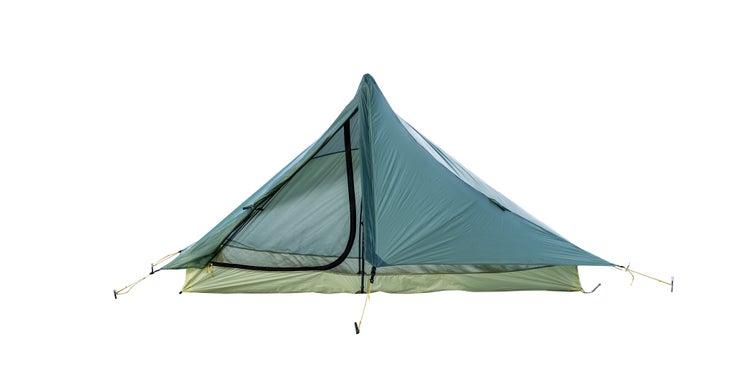
Our take For once in the ultralight tent category, more is better. This single-wall trekking pole tent is 2 ounces heavier than the previous version, but the new construction makes it a lot more livable. By moving the poles from the center of the shelter to the head, designers made The One 2 inches wider and 5 inches taller (up to 46 inches if your pole extends that high). “I’m 6’2” and I could sit up and read while trapped inside during pouring rain in Alaska’s Chugach National Forest,” our tester said, praising the tent’s peak height and 19.6 square feet of floor space. “Take a big gulp from your water bottle before you head out and you’ll have made up the weight difference from the original.”
The details The One’s 16-square-foot vestibule easily swallows a pack, boots, and wet gear. A secure pitch takes a minimum of four guylines and 10 stakeout points, and our Alaska tester reported no problems in 15-mph winds. Although wispy, the tent’s 7-denier body and 10-denier floor—both with sil/PU coating, and seam-sealed—stood up to rocky campsites in the Chugach with no signs of damage. Two floor vents (one at the head and one at the foot) offer some cross breeze but are easily blocked by gear, and our tester reports that The One’s subpar breathability resulted in a shower of dew after chilly nights.
Trail cred “Zippers can be finicky on some ultralights, but The One is easy to open and close without any snags,” one tester says.
$300; 1 lb. 5 oz.
Ultimate Direction FK Bivy
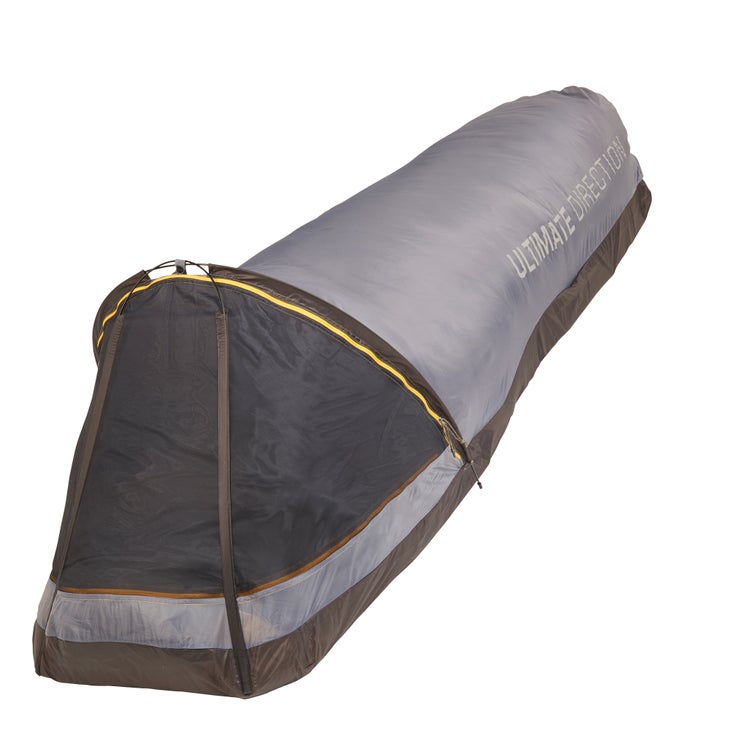
Our take At less than 9 ounces, the FK is lighter than other poled bivy structures, making it our top choice for the speed-hiking crowd. But check the forecast: The FK isn’t waterproof, so it’s best used to ward off wind, bugs, and condensation (pair with a tarp for rain). Still, the 24-inch shoulder width provides some (very relative) comfort. “It’s not a luxury suite, but I didn’t feel like I was sleeping in a coffin,” our tester said after climbing Maggie’s Peaks in California and deciding to stay the night.
$180; 8.8 oz.
Best 2 Person Tents
Two person tents sit in the sweet spot for a lot of backpackers: They’re big enough to fit a buddy, but small enough to work for solo adventures.
Eureka! Midori 2

Our take This two-person shelter achieves a rare trifecta: It’s spacious, durable, and affordable. A 30.6-square-foot floor—larger than usual—and dual doors kept our testers happy during a beach camping trip near Malibu, California. The 43-inch peak height and vertical walls allowed one 6’1” tester to sit up and change layers without grazing the ceiling, while a 68-denier poly-taffeta floor and fly held up to rocks and sand. Tradeoff: It’s a tad heavy for the category.
The details Our tester reported that the interior stayed dry on a mid-30s night near Bishop Pass, California. She also praised the two 10-square-foot vesitubles, which were good for cooking when ocean fog rolled in near Malibu. Nothing about the Midori screams cheap except for the stakes. Get better ones.
Trail cred “The four storage pockets on the sides of the canopy fit smaller items, and the location of the gear loft is smart,” one tester says. “They moved it to the foot area, which kept us from smacking into our stuff when sitting up.”
$160; 4 lbs. 13 oz.
Paria Outdoor Products Bryce 2P

Our take Usually, as a tent’s weight goes down, its price goes up. Not so with the Bryce. It’s a tent stake under 3 and a half pounds, has legit space for two, and costs just $160. Paria’s budget strategy: Sell directly to consumers, use cost-saving material like off-brand aluminum poles, and outsource design to the factory. The result is a value-priced shelter that still boasts high livability. “My daughter is 6’1” and I’m 6’6”, but we didn’t overlap or conk heads while spending some lazy afternoon hours hiding from mosquitoes in Idaho’s Frank Church-River of No Return Wilderness,” one tester says. Credit the Bryce’s above-average 31.3-square-foot floor.
The details Some lightweight shelters need TLC, but the Bryce’s 20-denier ripstop nylon fly and 40-denier nylon floor survived 12 weeks of daily use in the Frank Church with no unusual wear and tear. The single door and vestibule help save weight, but campers who like having their own storage areas will note the tradeoff. Ding: The fly design lets rain drip through the mesh door if the fly is not fully zipped.
Trail cred “The color scheme—an often-overlooked feature— is a pleasant amber hue, which creates a warm halo even in overcast conditions,” our tester reports.
$160; 3 lbs. 7 oz.
MSR Hubba Tour 2

Our take This single-wall tent’s gargantuan 25-square-foot vestibule (with a partial floor, on the half opposite the door) is a boon during extended wet weather, providing an extra room to store soggy gear, cook, and hang out. “Four of us could sit around and play a game of cards in there,” said one tester after a rainy weekend trip to Mississippi’s Black Creek Wilderness. A smaller storage port at the rear is great for stashing small items like wet boots. And reducing stormy-weather clutter is a cinch: Six mesh pockets (three on each end), a gear loft, and one long pocket in the vestibule are a neat freak’s dream. All that storage space is reflected in the price tag, though.
The details At 32 square feet—a notch larger than most two-person shelters—the Tour’s interior combines with an 88-inch length for ample living space. Nasty, 30-mph gusts and rain in Devil’s Den State Park in Arkansas weren’t a problem for the one-piece exoskeleton frame (plus a pole for the vestibule). Ventilation was an issue, though; our tester reported that condensation inside was a constant issue on muggy nights.
Trail cred “I let my 12-year-old daughter take the lead on our first setup, and we were able to pitch the tent in just three minutes,” says our tester.
$649; 4 lbs. 13 oz.
Big Agnes Tiger Wall UL2

Our take If you want an easy pitch, two doors, and freestanding convenience for a hair over a pound per person, this is your tent. Big Agnes has long been a dominant player in the ultralight category with the single-door Fly Creek (we gave it an Editors’ Choice Award in 2010), and the Tiger Wall adds another entrance for only 4 ounces more. Our tester was initially skeptical of the Tiger Wall’s space—the 28-square-foot floor is tight—but a few nights in Colorado’s Sawatch Range won her over. “My 6’4” boyfriend had no issues ducking into either of the two huge doors, and the 39-inch peak height let him sit (almost) all the way up,” she says. Two 8-square-foot vestibules fit packs, boots, and extra clothes, with room for her to struggle into some pants in the morning. The Tiger Wall sets up fast thanks to a hubbed pole system (it’s all but freestanding; the corners at the foot need to be staked out). While it’s not as big as the Tarptent (below), it’s an easier pitch and handles wind better.
The details You’ll want to treat the 15-denier nylon fabrics with care, but the Tiger Wall survived our initial forays just fine. After camping in the high desert near Fruita, Colorado, our tester said, “There was no place for a clear pitch, but this tent handled the rocks and sticks without any snags.”
Trail cred “On a chilly night in the Sawatch, we awoke to frost on the outside of our tent but no significant moisture inside,” our tester says.
$400; 2 lbs. 3 oz.
Tarptent Saddle 2
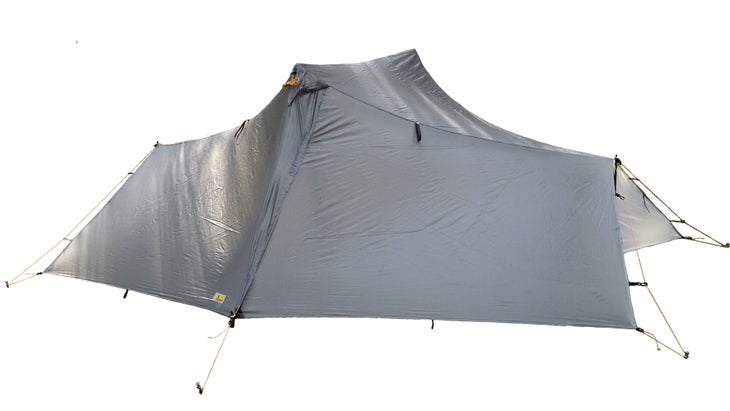
Our take To flirt with 2 pounds for a two-person shelter, you usually have to spend more for the lightest materials or settle for less space. The double-wall Saddle requires neither by using a trekking-pole pitch to create a 29.2-square-foot floor that’s on the spacious end for a two-person tent this light. Its 84-inch length and 41-inch peak height let our testers stretch out and play cards after 15-mile days on Vermont’s Long Trail. Double doors boost livability even more. (“Just don’t knock your poles down,” our tester says.) For hikers who don’t want to use trekking poles, tent poles can be purchased separately ($42; 10 oz.). There is a tradeoff: Pitching this shelter is a pain (with practice, our tester brought his PR down to six minutes).
The details Thanks to the full mesh walls on the inner tent, condensation was never a problem, even during a 35°F night. (For more insulation, an option with partially solid walls is available for $20 more.) Rain protection was no issue, but our tester was wary of the Saddle’s performance in particularly gusty weather. “In 15-mph winds, 6-inch strips of hook-and-loop closures at the base of the door came unstuck,” he says. “Pitch this tent in a sheltered spot.”
Trail cred “We had a warm autumn in New England, and the ability to break the Saddle down was great on toasty trips with clear weather and no bugs,” our tester says of the fly-only pitch, which brings total weight down to 1 pound 4 ounces.
$329; 2 lbs. 5 oz.
Best 3 Person Tents
Whether you’re bringing an extra hiking buddy or your dog, these three-person tents leave enough room for everybody and their gear.
Cabela’s Axis 3P

Our take We know that not everyone schleps their tent deep into the backcountry. So, if short treks, car, or canoe camps are your main deal, save a few hundred bucks and live large with the Axis. The 49.5-square-foot floor easily housed two adults and two infants on a canoe trip in Great Smoky Mountains National Park, and the 51-inch peak height allowed our 6’2” tester to kneel upright while putting his 11-week-old to sleep. Double vestibules (a whopping 18 square feet each) fit gear galore, while four mesh pockets and a gear loft keep essentials organized.
The details Even the crankiest toddler couldn’t damage this tent, thanks to burly, 40-denier mesh windows and 68-denier polyester floor and walls. Rain caused no problems, but the full vent-less fly did make for a stuffy stay in North Carolina’s Shining Rock Wilderness, where temps reached the mid-70s. Four guyout points achieve a taut pitch, but the tall profile caused shaking in 20-mph winds.
Trail cred “Setup is simple and fast, which I appreciated since we had
two hungry kids that needed to get away from the mosquitoes,” our tester says.
$200; 7 lbs. 11 oz.
My Trail UL 3
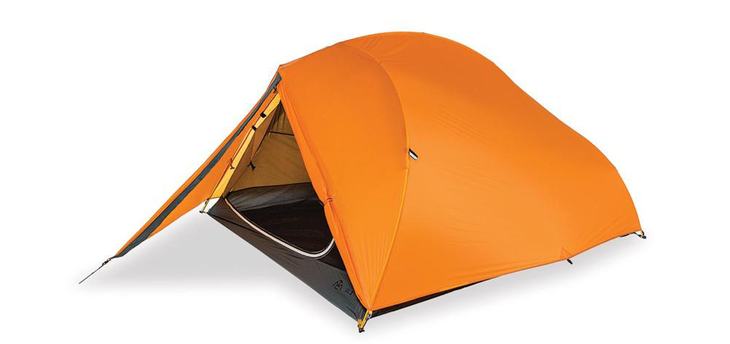
Our take In the dollars-spent-to-ounces-saved competition, the UL 3 wins, hands down. It’s so light we carried it as a two-person shelter, but it’s still big enough for three (as long as no one uses a pad wider than 20 inches). And, it costs some 25 percent less than similar ultralights. Testers were impressed in moderate conditions, from downpours in the Washington Cascades to light snow in the Colorado Rockies. But there is a discount tradeoff: The structure doesn’t offer adequate support in high winds, and when we staked and guyed the UL 3 out in 35-mph winds on New Zealand’s Mt. Taranaki, its aluminum poles bent (they didn’t break, though).
The details The UL 3 breathes extremely well, with no interior moisture even when temps dropped to 20°F outside Aspen, Colorado. The one-pole setup is easy, but the interior walls sag unless they’re staked out perfectly, a bummer if the tent is filled to capacity. Livability is what you’d expect from a tent at this weight and price: Only true minimalists will like a single door at the head and an 8-square-foot vestibule for three people.
Trail cred “With careful site selection, the 10-denier nylon fly and 20-denier nylon floor withstood a summer of backpacking around the Mountain West without suffering any damage,” our tester says.
$339; 3 lbs.
Mountain Hardwear Vision 3
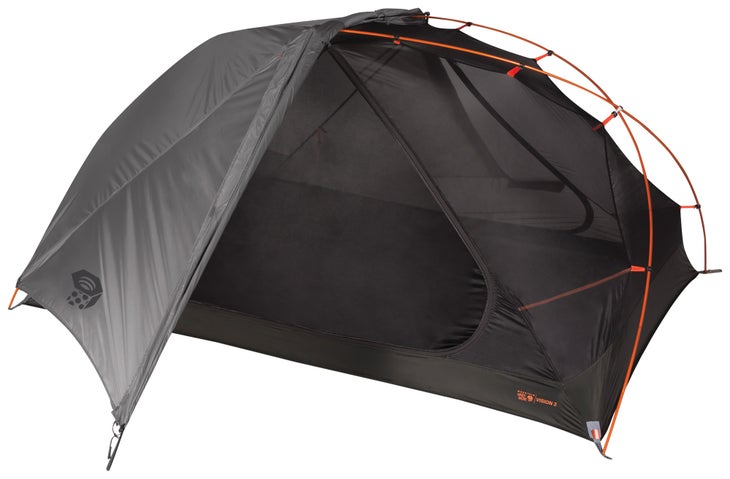
Our take If you like the idea of sleeping under the stars more than the reality of buzzing insects and dew on your sleeping bag, here’s your tent. Simply roll back the Vision’s fly and secure it at the top with toggles for unfettered stargazing; it’s easy to roll back down and redeploy the stakes in case of rain, as one tester found out during a sudden shower on Washington’s Olympic Peninsula, during which the taut pitch shed water well. Despite the mesh, durability proved high. Both Boy and Girl Scout troops took the Vision for a spin, and the 70-denier nylon taffeta floor suffered no damage.
The details The 37.5-square-foot floor is small for its class, so it’s best to sleep head-to-foot for maximum wiggle room (that’s the tradeoff for the Vision’s relatively low weight.) Two 55-inch-wide doors and dual vestibules (9 square feet each) stash three people’s gear, but one tester noted that he had to lean the backpacks against the tent wall to make it all fit.
Trail cred The Vision’s mostly-mesh construction means it vents well. “Even on humid nights in the Hoh Rain Forest, the interior was never too moist or stuffy,” our Washington tester says.
$349; 5 lbs. 7 oz.
Marmot Fortress 3P

Our take The Fortress lived up to its name through 40-mph winds, a torrential downpour, freezing rain, and light snow in California’s Desolation Wilderness. “My mom slept in a different tent, and not only did she have to physically hold it up from the inside against the wind, but her zipper failed in the ice,” one tester recounts. But the Fortress’s bomber 68-denier polyester fly and floor kept the rain out and maintained a taut pitch, even when drenched (polyester doesn’t stretch when wet, like nylon does).
The details The 41.5-square-foot floor is average for this category, but is improved by the 90-inch length (you can stash more gear at the foot) and 46-inch peak height. “It was so nice to have extra headroom while waiting out the storm,” our tester said after the freezing sleet in California. Two vestibules (10.6 and 7.8 square feet) house gear, but the low-angle rainfly made entry tricky, and it’s hard to reach the zipper from inside the canopy. Bonus: reasonable price.
Trail cred “I’m usually all about lightening the load, but on trips where I know the tent’s going to get roughed up, the Fortress’s durability-to-weight ratio is worth it,” said one tester after four days of gnarly off-trail hiking in Washington’s Chiwaukum Mountains.
$289; 6 lbs.